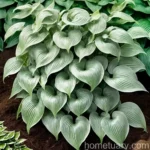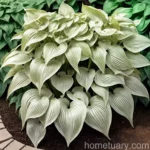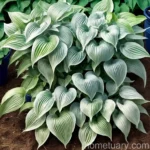All About Hosta (Hosta ‘Gypsy Rose’)
Introduction
Plants are an essential part of the natural world, offering beauty, oxygen, and sustenance. One such plant that has captivated the hearts of gardeners and enthusiasts is the Hosta, and among its numerous varieties, the Hosta ‘Gypsy Rose’ stands out with its unique characteristics and versatility. In this comprehensive guide, we will delve into the world of Hosta ‘Gypsy Rose,’ exploring its care, characteristics, uses, and much more, aiming to equip you with all the knowledge you need to cultivate and enjoy this stunning plant.
What is Hosta ‘Gypsy Rose’?
Hosta ‘Gypsy Rose’ is a cultivar of the Hosta genus, known for its stunning foliage and ease of cultivation. This perennial plant is a favorite among gardeners, cherished for its vibrant leaves and adaptability to various growing conditions. The ‘Gypsy Rose’ variety is particularly prized for its striking foliage and low-maintenance nature, making it a popular choice for both beginner and experienced gardeners.
This Hosta variety boasts heart-shaped leaves with a blend of colors, ranging from deep green to vibrant purples and grays, creating a captivating display in garden beds, borders, and containers. With its compact size and outstanding foliage, it serves as an excellent choice for landscaping, adding visual interest and texture to any outdoor space.
Hosta ‘Gypsy Rose’ is a remarkable addition to shade gardens, where its tolerance for low light conditions makes it thrive. Its versatility extends to container gardening, where it can be showcased on patios, balconies, and other compact spaces. With proper care and attention, this Hosta variety can grace your outdoor areas with its distinct beauty and resilience.
Key Takeaways – Hosta (Hosta ‘Gypsy Rose’)
Culture
- Family: Asparagaceae
- Genus: Hosta
- Species: ‘Gypsy Rose’
- Type: Perennial
- Hardiness Zone: 3-9
- Mature Size: 12-18 inches tall, 24-36 inches wide
- Foliage: Heart-shaped, variegated, vibrant green, purple, and gray hues
- Flowering: White or light lavender bell-shaped blooms in summer
Uses
- Landscaping: Ideal for borders, edging, and groundcover
- Container Gardening: Well-suited for potted arrangements
- Shade Gardens: Flourishes in low light conditions
- Focal Point: Adds visual interest as a standout plant
- Companion Plant: Versatile for pairing with other shade-loving species
- Foliage Display: Showcases diverse leaf colors and patterns
Water
- Frequency: Regular watering to keep soil consistently moist
- Avoid: Waterlogging and standing water
Sunlight
- Preferred: Partial to full shade, protection from direct sunlight
- Tolerance: Can endure low light conditions
Fertilizer
- Application: Balanced, slow-release fertilizer in spring
- Frequency: Once a year for established plants
- Dilution: Follow manufacturer’s instructions for proper dilution
Soil
- Type: Well-drained, rich, and slightly acidic soil
- Amendment: Incorporate organic matter for improved texture and nutrients
- PH Level: Ideally between 6.0-7.5
Pruning
- Deadheading: Remove spent flower stalks for neat appearance
- Trimming: Trim damaged or withered foliage as needed
- Winter: Clear away dead leaves for a tidy appearance
Propagation
- Division: Divide mature plants in early spring or fall
- Separation: Separate rhizomes carefully to ensure viability
- Transplanting: Replant divisions in desired locations promptly
Container Popularity
- Appeal: Well-suited for container gardening due to compact size
- Aesthetics: Enhances patios, balconies, and small outdoor spaces
- Maintenance: Simplifies care and maintenance in contained environments
Common Diseases
- Leaf Spot: Recognized by brown or black spots on foliage
- Crown Rot: Results in wilting and decay of the plant’s crown
- Prevention: Maintain proper air circulation and avoid overwatering
Disease Diagnosis
- Visual Inspection: Check for discoloration, wilting, and abnormal growth
- Fungal Tests: Utilize professional kits for diagnosing fungal infections
- Prompt Action: Address diseases early to prevent spread
Common Pests
- Slugs and Snails: Attracted to Hosta foliage, particularly in moist conditions
- Deer: May feed on Hosta leaves, especially in areas with high deer populations
- Preventive Measures: Use natural or commercial deterrents for pest management
Botanist’s Tips
- Mulching: Apply mulch to retain moisture and regulate soil temperature
- Airflow: Ensure proper spacing to facilitate air circulation and reduce disease risk
- Seasonal Care: Adjust watering and maintenance based on seasonal changes
Fun Facts
- Origin: Hosta genus is native to East Asia
- Diversity: Hosta encompasses thousands of cultivars with varied characteristics
- Landscape Use: Hostas are prevalent in both residential and public gardens worldwide
Links to External Resources
To further enrich your understanding of Hosta ‘Gypsy Rose’ and its care, we recommend exploring the following resources:
1. The American Hosta Society
2. Royal Horticultural Society – Hostas
3. University of Illinois Extension – Hosta Plants
Conclusion
As we conclude our comprehensive guide to Hosta ‘Gypsy Rose,’ it is evident that this unique plant offers an array of benefits to gardeners and landscaping enthusiasts. Its captivating foliage, resilience in shade, and adaptability to different growing conditions make it a valuable addition to gardens and outdoor spaces. By understanding the key aspects of its care, from watering and sunlight requirements to soil and pest management, you can cultivate and enjoy the beauty of Hosta ‘Gypsy Rose’ to the fullest.
Whether you are embarking on a new gardening venture or seeking to enhance your existing landscape, integrating Hosta ‘Gypsy Rose’ can elevate the visual appeal of your outdoor environment. With the right practices and attention to detail, you can nurture thriving Hosta displays, creating stunning focal points, borders, and container arrangements. Embrace the allure of Hosta ‘Gypsy Rose’ and unlock the potential for a vibrant, captivating garden space.
References
- https://www.hosta.org/
- https://www.rhs.org.uk/plants/popular/hosta
- https://extension.illinois.edu/hortanswers/plantdetail.cfm?PlantID=911&PlantTypeID=11















